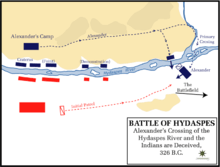326 BC
| 326 BC by topic |
| Politics |
|---|
|
| Categories |
|
| Gregorian calendar | 326 BC |
| Ab urbe condita | 428 |
| Ancient Egypt era | XXXII dynasty, 7 |
| - Pharaoh | Alexander the Great, 7 |
| Ancient Greek era | 113th Olympiad, year 3 |
| Assyrian calendar | 4425 |
| Bengali calendar | −918 |
| Berber calendar | 625 |
| Buddhist calendar | 219 |
| Burmese calendar | −963 |
| Byzantine calendar | 5183–5184 |
| Chinese calendar | 甲午年 (Wood Horse) 2371 or 2311 — to — 乙未年 (Wood Goat) 2372 or 2312 |
| Coptic calendar | −609 – −608 |
| Discordian calendar | 841 |
| Ethiopian calendar | −333 – −332 |
| Hebrew calendar | 3435–3436 |
| Hindu calendars | |
| - Vikram Samvat | −269 – −268 |
| - Shaka Samvat | N/A |
| - Kali Yuga | 2776–2777 |
| Holocene calendar | 9675 |
| Iranian calendar | 947 BP – 946 BP |
| Islamic calendar | 976 BH – 975 BH |
| Julian calendar | N/A |
| Korean calendar | 2008 |
| Minguo calendar | 2237 before ROC 民前2237年 |
| Thai solar calendar | 217–218 |
| Wikimedia Commons has media related to 326 BC. |

The Battle of Hydaspes
Year 326 BC was a year of the pre-Julian Roman calendar. At the time, it was known as the Year of the Consulship of Visolus and Cursor (or, less frequently, year 428 Ab urbe condita). The denomination 326 BC for this year has been used since the early medieval period, when the Anno Domini calendar era became the prevalent method in Europe for naming years.
Events
By place
Macedonian Empire
- Spring – Alexander the Great crosses the Indus near Attock and enters Taxila, whose ruler, Taxiles (or Ambhi), furnishes 130 war elephants and troops in return for aid against his rival Porus, who rules the lands between the Hydaspes (modern Jhelum River) and the Acesines (modern Chenab River).
- On the left bank of the Hydaspes, Alexander fights his last great battle, the Battle of the Hydaspes River. He and his general Craterus defeat the Indian King Porus. Alexander founds two cities there, Alexandria on the Indus or Alexandria Nicaea (to celebrate his victory) and Alexandria Bucephalous or Bucephala (named after his horse Bucephalus, which dies there); and Porus becomes his ally.
- Philip, an officer in the service of Alexander the Great, is appointed satrap of India, including the provinces to the west of the Hydaspes, as far south as the junction of the Indus with the Acesines. Philip is put in charge by Alexander of building the city of Alexandria on the Indus.
- Alexander continues on to conquer all the headwaters of the Indus River. East of Porus' kingdom, near the Ganges River, Alexander faces the powerful empire of Magadha ruled by the Nanda dynasty. Fearing the prospects of facing another powerful Indian army and exhausted by years of campaigning, his army mutinies at the Hyphasis River (the modern Beas River) and refuses to march further east, thus making this river mark the eastern-most extent of Alexander's conquests.
- Following the mutiny of his army at the Hyphasis River, Alexander is persuaded by his army leaders to abandon his plans for invading the Ganges Valley. Alexander appoints Nearchus, a Cretan with naval experience, as admiral and places under his command all in the ranks of his army with any knowledge of seafaring. Nearchus has Indian shipwrights build 800 vessels, some as large as 300 tons, to take the army through Persian Gulf waters to Babylon. Alexander the Great begins the return march down the Indus to the sea.
- After the departure of Alexander from India, Philip is assassinated by some of the mercenary troops under his command. Alexander names Eudamus and Taxilas as replacement rulers of Philip's territories.
Roman Republic
- Following their defeat by the Roman forces in Naples, the Samnites declare war on Rome starting the Second Samnite War. To help defeat the Samnites, the Romans make alliances with the peoples of Central Italy to the north of Samnium and with the Apulians to the southeast.
Births
- Pharnavaz I of Iberia, later King of Iberia
Deaths
- Coenus, son of Polemocrates and son-in-law of Parmenion and one of Alexander the Great's generals in his Persian and Indian expeditions